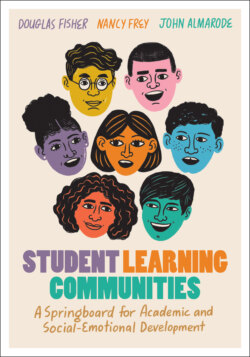Читать книгу Student Learning Communities - Нэнси Фрей - Страница 26
На сайте Литреса книга снята с продажи.
Foster Group Cohesion
ОглавлениеSocial connectiveness is vital in collective learning tasks performed by SLCs. Teams in general work better when there is a shared motivation to complete the task; such groups typically outperform those who do not share a collective motivation (Kozlowski & Ilgen, 2006).
Shared motivation may be enhanced or diminished by the group's cohesion, which is the members' feeling of commitment to one another. As social beings, cohesion and connection to others influence many groups—from family and friendship groups to those in the workplace, in recreational activities, and in school. Consider the times when you have been involved in a game or a project but felt that another person wasn't as invested. Whether playing a board game or cleaning the gutters on the house, the perception that someone else is going through the motions affects the degree of enjoyment you experience … and your task performance. Although motivation is cognitive, as one appraises the task, connectedness is affective: it comes from perceptions and emotions.
Social cohesion builds throughout childhood and adolescence as prosocial skills such as helping and sharing develop and children become increasingly better at perceiving the thoughts and feelings of others. Young children need opportunities within tasks to build social bonds. Team roles that promote these skills include the materials manager, the recorder, and the timekeeper. We sometimes add a "spy" role on a team. This person's job is to seek help on behalf of the group, whether from the teacher or from another group. The "spy" role works in a virtual environment, too. While the group is in a virtual breakout group, the "spy" can send a message to the teacher to "drop in" on another group, then take back information. Each of these roles is meant not only to assist the team in working more efficiently but also to foster the affiliation members have for each other.
Although older students may not require formal roles, attention to cohesion remains crucial. A major principle of SLCs is that collective decision making must be present (Roberson & Franchini, 2014). The possibility of failure and the relative challenge of the task contribute to an SLC's level of cohesion, but restricted decision-making opportunities are also important in drawing the SLC together. Ask groups to arrive at consensus, not just complete a task. The process of having to come to consensus promotes their affiliation and social cohesion as they draw together as a team. Roberson and Franchini's (2014) suggestions for different types of group assignments can be used to insert an element of consensus seeking into any task, in any content area. They are listed below, along with examples:
Ranking. Rank the following solutions in order of their plausibility.
Sorting. In the envelope on your table are strips of paper, each listing a statement about X phenomenon. Sort them according to the four theories we have been studying.
Scoring. Read the following excerpt. On a scale of 1 to 4, assign a score that indicates how successfully this writer has applied X principle.
Sequencing (chronological, procedural, logical, or narrative). Place the following events in chronological order. Place the following steps in the order that represents the most effective procedure for solving X problem.
True/false. Evaluate the following statements and decide as a team whether they are true or false. Be prepared to explain and defend your team's answers.
What does not belong? Look at this diagram that lists 10 items. With your team, select the 5 items that have the greatest impact on X phenomenon.
